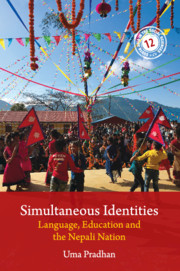Book contents
- Frontmatter
- Contents
- List of Figures
- List of Tables
- List of Appendices
- List of Abbreviations
- Acknowledgements
- Notes on the Use of Terms, Transliteration and Names
- Introduction: Language, Education and the Nepali Nation 1
- 1 Language, Education and State-Making in Nepal
- 2 Mother Tongue and the Construction of an Educated Person
- 3 Language, Public Space and Identity
- 4 Transforming Language to a Script
- 5 Language, Education and Knowledge-Making
- 6 Quality, Equality and Language Ideology
- 7 Ethnicity, Education and Employment
- Conclusion: Simultaneous Identities
- Appendices
- Glossary
- Bibliography
- Index
Introduction: Language, Education and the Nepali Nation 1
Published online by Cambridge University Press: 30 April 2020
- Frontmatter
- Contents
- List of Figures
- List of Tables
- List of Appendices
- List of Abbreviations
- Acknowledgements
- Notes on the Use of Terms, Transliteration and Names
- Introduction: Language, Education and the Nepali Nation 1
- 1 Language, Education and State-Making in Nepal
- 2 Mother Tongue and the Construction of an Educated Person
- 3 Language, Public Space and Identity
- 4 Transforming Language to a Script
- 5 Language, Education and Knowledge-Making
- 6 Quality, Equality and Language Ideology
- 7 Ethnicity, Education and Employment
- Conclusion: Simultaneous Identities
- Appendices
- Glossary
- Bibliography
- Index
Summary
Jigu dei jita: ya:, jigu bhay jita: ya:
Jigu mama bhasha, tasakan jita: ya:
Jipi he thwo dey ya, tisa kha: chha maya
Jimita tiya chha, chaka: sa nhilabyu.
Pahad, Parvat, Himal, Tarai.
Guli na du jaati, bhasa phukka ya:
Jugu dei jita: ya:, jigu bhay jita: ya:
Jigu mama bhasha, tasakan jita: ya
I love my country, I love my language
My mother tongue, I love it very much
We are the jewels of this country, o’ mother
Adorned by us, smile at us once
Hills, Mountains, Plains
We love all ethnic groups and all languages
I love my country, I love my language
My mother tongue, I love it very much
Every morning, students in Jagat Sundar Bwonekuthi (JSB) School gathered in the main hall to sing their school song. Students, lined up neatly in their class rows, sang this song in Nepal Bhasa, one of the 123 minority languages in Nepal. The song portrays an image of Nepal with diverse terrain – hills, mountains and Tarai – where different groups speaking different languages are the ‘jewels’ that adorn the country. This discursive move to invoke the love for one's country, while declaring the love for one's mother tongue (matri bhasa), was one of the important ways in which JSB sought to institutionalise their mother tongue as the language of education. In this context, the school song simultaneously positioned ethnolinguistic identity as national identity, the one that does not hinder but bolsters the notion of Nepali nationhood. A few months later, I continued my fieldwork in another school that used Dangaura Tharu as the medium of instruction: Jana Kalyan Higher Secondary School ( JKHSS) in Kapilvastu. In the very first meeting at JKHSS, the teachers discussed extensively on the new multilingual textbook that they had been using in primary level, that is, Grades I–III. Showing me the textbook with Dangaura Tharu and Nepali language scripts simultaneously printed on every page (more discussion on this in Chapter 4), JKHSS teachers explained, ‘Each language has its role.’ I was often told during our conversations, ‘Mother tongue cannot replace Nepali because Nepali is the contact language.
- Type
- Chapter
- Information
- Simultaneous IdentitiesLanguage, Education, and the Nepali Nation, pp. 1 - 30Publisher: Cambridge University PressPrint publication year: 2020



